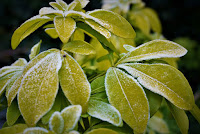Beware of Winter Storm Quinlan
According to Accuweather.com, “more than 150 million people will face some type of impacts from the storm east of the Mississippi River, but the Northeast, which received accumulating snow on Wednesday on the heels of record-challenging warmth on Monday, is likely to take the brunt of the impacts as the storm rapidly strengthens into a bomb cyclone along the Eastern Seaboard.” The storm is named Quinlan.”
It’s that “record-challenging warmth” before the storm that concerns us most. Warm weather induces new growth on winter-dormant plants. When followed the freezing temperatures, the new growth – leaves, flowers and all – are damaged or destroyed. Not only that, but previously dormant plants lose some of their winter hardiness, so Quinlan can be particularly devastating.
I’ve been receiving calls from gardeners, particularly in the south where warm weather persists today, but where below-freezing temps are forecast for the weekend. From citrus trees, blueberry bushes to annuals and azaleas, they wonder how to treat them.
Here are my suggestions.
Some spring-planted annuals should be cold-hardy enough. Snapdragons and pansies, for example, should be safe enough without protection. Petunias, begonias and the like will need attention. Flowering trees and shrubs will also require some care.
Container gardens may be moved into a garage, sun room or basement. If they’re too large to move inside, or too dirty, position them near a south or west-facing wall. Brick walls are the best, but any will do, nor matter the direction it faces. Radiant heat will moderate the temperature around them.
Whether container-grown or established outdoors, sensitive plants can be covered with fabric. Old sheets will work. Blankets might be too heavy and cause damage.
Do not use plastic sheeting or tarps. Beside providing too little thermal protection, plastic in contact with foliage will allow moisture to condense on the inner surface and the leaves to freeze to the material. Furthermore, solar heat can build up during the day and cook your plants.
If safety precautions are taken, letting a fire pit or barbecue grill smolder all night can raise the temperature around it just enough to protect your patio plants. Propane patio heaters can do the trick. Even light bulbs strategically placed and left on all night can help. Never leave open flames unattended.
Sometimes frost doors more damage than the surrounding cold air. Outdoor fans left running can keep the air circulating and prevent frost from settling on your plants.
These are the most common strategies that homeowners can take to help their plants survive cold nights. If you try any of them, be sure to let us know how they work for you under your circumstances. Your observations can help other gardeners cope in the future.
Return to GoGardenNow.com.







No comments:
Post a Comment